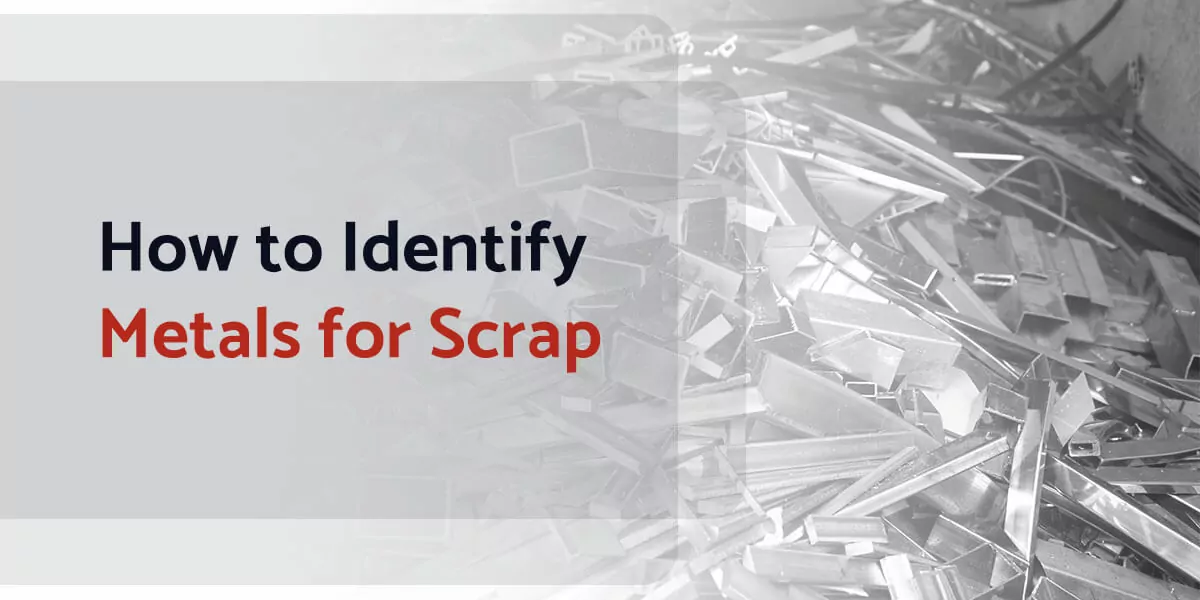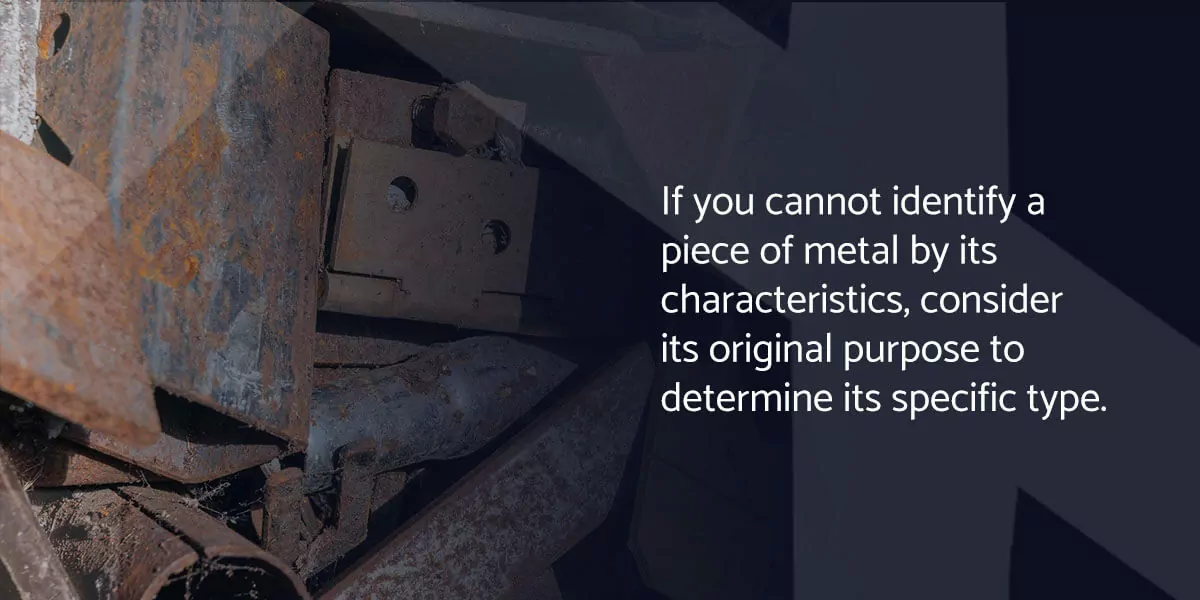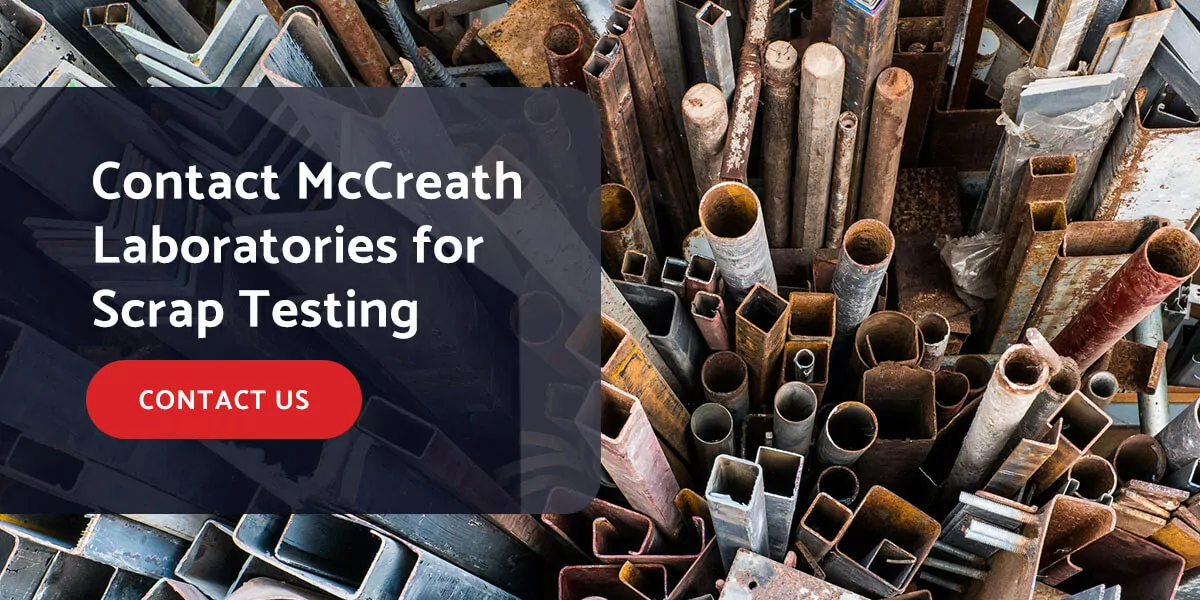How to Identify Metals for Scrap
Scrap metal is a valuable part of production systems. Instead of mining for new resources each time new products need steel materials, you can melt and repurpose scrap. If you find scrap, you may want to test it to determine its value and distinguish what materials it consists of so you can use it again with confidence.
What Is Scrap?
Scrap consists of discarded ferrous and non-ferrous metal produced both during the manufacturing process of metal products as well as from the recycling of consumer products. For over 150 years, the steel industry has been recycling and using scrap to produce steel. Using recycled scrap as raw material in steel production lowers overall costs and is more environmentally friendly.
Mills that consume scrap not only reduce their consumption of new resources but also reduce the amount of greenhouse gas emissions that they produce. Scrapyards and scrap recycling facilities segregate, sort, and further process scrap materials by grade and by intended use. Standards for the classification of steel scraps have been developed by the Institute of Scrap Recycling Industry (ISRI). These standards provide specifications for the classification of steel scrap based on the type, sizing, and metallic and residual composition.
How Can You Identify Scrap Metals?
Understanding how to identify metals for scrap can help you sort different metal types properly and reuse them for the correct purposes. Metals are identified by different traits. You can complete metal identification and sort various types of scrap metals by the following traits:
Identify Metal by Color
Some metals have distinctive colors that indicate what types they are. You can determine some metals simply by the coloring of the metal. However, it’s important to remember that some metals are painted or rusted, so their appearance may differ from their original, natural color. You can chisel paint or rust off of metal to see its true color and sort it correctly.
Copper-colored metal is usually red brass or copper. Copper is challenging to cast, so molded or cast metal is most likely red brass. Gold-colored metals are different from metal gold. Metal gold is almost the same color as brass, but it is darker and less yellow than brass. If you have gold-colored metals, they are most likely brass because metal gold is rarer than brass.
Identify Metal by Magnetism
A metal’s magnetic response can tell you whether it’s ferrous or non-ferrous. Hold a regular magnet to a piece of metal you want to identify. Ferrous metal contains iron and is attracted to magnets, so you can identify it as an iron alloy if the magnet sticks to the metal. Non-ferrous metal is without iron and is not attracted to magnets. If a magnet does not stick to a piece of metal, it is a non-magnetic metal such as brass or aluminum.
Identify Metal by Hardness
Some metals are harder than others. You can test a metal’s hardness with a mill file or a cold chisel and hammer.
- Pure copper: Pure copper is a softer metal. If you file a piece of metal with a mill file and it flakes easily, it is most likely pure copper.
- Steel: Steel is harder and flakes less easily than copper.
- Cast iron: If you use a cold chisel and a hammer to test a metal’s hardness and you get brittle flakes that break easily, it is likely cast iron.
- Aluminum, steel and malleable iron: If chiseling a piece of metal gives you continuous, durable flakes that don’t break easily, you most likely have malleable iron, aluminum or steel.
Identify Metal by Oxidation
A metal’s oxidation or lack of oxidation reveals details about its chemical makeup and what type of metal it is. A metal’s condition and age can affect its oxidation, so newer and well-maintained metals may not have any oxidation to reveal their identity. To identify metals by oxidation, you can look for the following indicators:
- Green coloring: When copper and bronze metals rust, they develop a green color.
- Red rust: A distinctive red rust color indicates that a piece of metal contains iron.
- No oxidation: Stainless steel and chromium do not oxidize.
Identify Metal by Weight
Certain metals are heavier or lighter than others. You can feel a piece of metal’s weight or weigh it on a scale to determine what type it is. Iron and lead are on the heavier side, while aluminum is more lightweight and easy to bend.
Identify Metal by Original Usage
Considering how a piece of metal was used before it became scrap metal can also help you identify its specific type. Certain types of metal are ideal for different applications. Iron is primarily used for indoor applications because it rusts easily. Copper is commonly used in electrical wiring because it conducts electricity effectively. You will never find tin in plumbing pipes because it is easily bent. If you cannot identify a piece of metal by its characteristics, consider its original purpose to determine its specific type.
Send Us Your Steel Scrap Sample
Why Test Metal Scrap?
After metal scraping, testing the metal scrap is an integral part of the recycling process. Scrap can fall into one of two classifications – ferrous or non-ferrous. The main difference between the two is that ferrous scrap contains iron as a major component, while non-ferrous scrap does not.
Ferrous and non-ferrous scraps benefit from different construction procedures. When you know the composition of the scrap, you can make decisions on how to use it to make new products or steels.
The Challenges of Testing Metal Scrap
Though scrap testing is an important part of the recycling process for steel, it poses a few challenges. To test metal scrap, you will need a solid, homogenous sample for consistent results. You can melt scrap to get a homogenous sample. In some cases, you may need to add iron to the sample to help the scrap melt. You will also need to ensure the sample is large enough for testing.
When you want to have scrap tested, it’s vital to go to a professional for expert analysis. Professionals use specific furnaces for testing because they need to test a certain amount of scrap for reliable results. When iron is added to the sample, the person melting it must understand how much of the original sample remains after reduction. Having an expert team test and analyze your scrap sample from start to finish is the best way to know you’re getting accurate, consistent results.
How Are Metal Scrap Samples Tested?
Understanding how to test metal types and how to tell what kind of metal something is, is a delicate science. Once professionals collect a homogenous sample, they can begin testing scrap. The professionals will pour the molten metal into a mold, which creates a coin used for testing. There are two ways to analyze the scrap sample — X-ray fluorescence (XRF) analysis and optical emission spectroscopy (OES) analysis. Both procedures for analysis can will provide the elemental composition of the sample.
XRF analysis uses fluorescent X-rays to determine the elements present in the sample. It’s a non-destructive technique that offers fast, accurate results. The coin sample must be polished to a mirror-like finish to give the X-rays a good surface for analysis.
OES analysis involves the use of an instrument to spark the sample and identify the elements it contains. This optical technique can determine multiple elements including light elements such as carbon and boron. A rough surface is necessary to yield accurate results through OES analysis. The appropriate surface can be achieved through the use of sandpaper or a grinder.
How Is Scrap Quality Assessed?
When testing is complete, you can have scrap quality assessed. Professionals can determine scrap quality through the use of grading systems that set minimum and maximum content for specific metal impurities. Grading systems also set the restriction levels of certain hazardous metals and substances that could be present in scrap. The specifications and grading systems ensure consistent quality for a given grade of scrap.
The specifications come from regional classifications developed by the European Ferrous Recovery and Recycling Federation and the Institute of Scrap Recycling Industries, Inc. in the United States. By following the specifications, you can ensure your scrap is in its best condition. The elements found in scrap have different values, so you can benefit from having multiple materials.
Contact McCreath Laboratories for Scrap Testing
Scrap metal’s recyclable properties ensure steel production can continue for many years. When you have scrap tested, you will know what elements it consists of so you can determine its value. Professional testing and analysis can save you time and keep you safe. McCreath Laboratories is an independent testing laboratory with multiple locations that has been a leader in the industry for more than 147 years, so you can count on us to handle the testing process from start to finish.
If you have scrap that needs testing, contact us to learn more about how we can help. Submit a sample for testing today for an expert, third-party analysis of your scrap metal sample.


